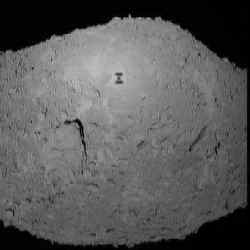
Hayabusa descending on Itokawa before landing. Image credit: JAXA Click to enlarge
Hayabusa attempted its first soft-landing on Itokawa for the purpose of touch down and sample collection on November 20-21, 2005. Below is the data information with the related advance report on its status.
Hayabusa started descending at 9:00pm on Nov. 19th, 2005 (JST) from 1km in altitude. The guidance and navigation during the process of approach was operated normally, and at 4:33am on Nov. 20th, the last approach of vertical descent was commanded from ground, of which soft-landing was successfully achieved almost on the designated landing site of the surface. Deviation from the target point is now under investigation but presumed within a margin of 30cm.
The velocity at the time of starting descent was 12cm/sec. At the altitude 54m at 5:28am, wire-cutting of target marker was commanded, after which, at 5:30am at altitude 40m, the spacecraft autonomously reduced its own speed by 9cm/sec to have substantially separated the target marker. It means that Hayabusa’s speed became 3 cm/sec. Separation and freefall of the marker was confirmed from the image as well as from descending velocity of the spacecraft at the time of reducing the speed. The marker is presumed to have landed on southwest of MUSES Sea.
Hayabusa then switched its range measurement from Laser Altimeter (LIDAR) to Laser Range Finder (LRF) at the altitude 35m and moved to hovering by reducing descending speed to zero at 25m above the surface, below where Hayabusa, at 5:40am at altitude 17m, let itself to freefall, functioning itself to the attitude control mode adjustable to the shapes of the asteroid surface. At this point, the spacecraft autonomously stopped telemetry transmission to the earth (as scheduled) to have changed to transmission with beacon mode more efficient for Doppler measurement by switching to low gain antenna (LGA) coverable larger area.
Since then, checking of the onboard instruments was not possible on a real time basis (as scheduled), but as a result of analyzing the data recorded onboard and sent back to the earth in the past two days, Hayabusa seemed to have autonomously judged to abort descending and attempted emergency ascent because its Fan Beam sensors for obstacle checking detected some kind of catch-light. Allowable margin is set for Hayabusa for its attitude control, in the case the spacecraft takes off the ground by accelerating the velocity on its own. Under such circumstances, the then spacecraft’s attitude was out of the margin, because of which continuing of safe descent was consequently chosen. As a result, Hayabusa did not activate its Touch Down Sensor function.
At the timepoint of Nov. 21, Hayabusa was judged not to have landed on the surface. According to the replayed data, however, it was confirmed that Hayabusa stayed on Itokawa by keeping contact with the surface for about 30 minutes after having softly bounced twice before settling. This can be verified by the data history of LRF and also by attitude control record.
This phenomenon took place during switching interval from Deep Space Network (DSN) of NASA to Usuda Deep Space Center, because of which the incident was not detected by ground Doppler measurement. The descending speed at the time of bouncing twice was 10cm/sec. respectively. Serious damage to the spacecraft has not been found yet except heating sensor that may need checking in some part of its instrument.
Hayabusa kept steady contacting with the surface until signaled from ground to make emergency takeoff at 6:58am (JST). The Touch Down Sensor supposed to function for sampling did not work because of the reason above stated, for which reason firing of projector was not implemented in spite of the fact that the spacecraft actually made landing. The attitude at landing is so presumed that the both bottom ends of +X axis of sampler horn and either the spacecraft or tip end of the solar panels was in contact with the surface. Hayabusa became the world-first spacecraft that took off from the asteroid. Really speaking, it is the world-first departure from an celestial body except the moon.
After departure from the asteroid by ground command, Hayabusa moved into safe mode due to the unsteady communication line and the conflict with onboard controlling and computing priority. The comeback from safety mode to normal 3-axis control mode needed full two days of Nov. 21 and 22. Owing to this reason, replaying of the data recorded on 20th is still midway, which means the possibility to reveal much more new information through further analysis of the data. As of now, the detailed image of the landing site to know its exact location has not been processed yet. Hayabusa is now on the way to fly over to the position to enable landing and sampling sequence again. It’s not certain yet if or not descent operation will be able to carry out from the night of Nov. 25 (JST). We will announce our schedule in the evening of Nov. 24.
Descending and landing operation will all depend upon availability of DSN of NASA. We would like to express our sincere gratitude for cooperation of NASA for tracking networks including backup stations.
Original Source: JAXA News Release
